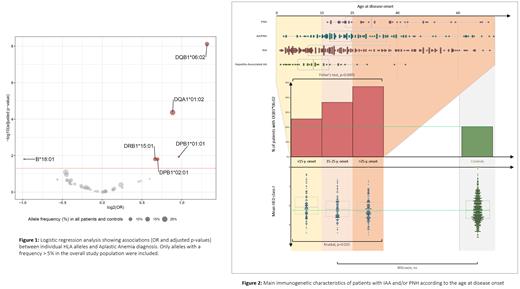Over the past decade, the role of HLA molecules in the pathophysiology of immune aplastic anemia (IAA) has been highlighted by the identification of somatic clonal losses of HLA molecules on leukocytes and the enrichment of certain HLA alleles in patients with AA compared to the general population. More recently, the analysis of the HLA Evolutionary Divergence (HED) score in a large US adult cohort showed that IAA patients were carrying class II HLA molecules whose antigen-binding sites were characterized by a high degree of structural homology and that low class II HED score was associated with a higher risk of malignant progression and poorer survival (Pagliuca et al., Blood, 2021). To evaluate these findings in an independent cohort, we conducted a retrospective study of a large cohort of adult and pediatric patients diagnosed with IAA and/or PNH included in 2 different centers in Paris from the French National Center for Aplastic Anemia (RIME observatory).
Patients' 2-field HLA genotyping for HLA-A, -B, -C, -DRB1, -DQB1 and -DPB1 loci and HLA-DQA1 genotype imputations were compared with those of a control cohort of 593 allogeneic donors in the context of hematologic malignancies. The MidasHLA R package was used to assess HLA-disease associations using logistic regression analysis with a dominant inheritance model (Benjamini-Hochberg adjusted p-values). HED metrics, used as a surrogate for the width of the immunopeptidome presented by the patient's HLA molecules (Pierini and Lenz, Mol. Biol. Evol., 2018) were calculated for the different HLA loci and for the entire HLA class I and HLA class II genes (mean of HED scores for the corresponding loci).
The cohort consisted of 449 patients who were children (<15 years of age, n=130), adolescents and young adults (15-25 years of age, n= 141), and adults (> 25 years of age, n= 178) at the time of diagnosis. Fifty-five percent had IAA, 28% had AA with a PNH clone, 8% had hepatitis-associated AA and 9% had hemolytic PNH. The distribution of diagnoses differed across age groups, with a decreasing incidence of hepatitis-associated AA and an increasing incidence of both AA/PNH and PNH with age.
We first confirmed a strong association between patients and the DRB1*15:01, DQB1*06:02 and DQA1*01:02 alleles (these 3 alleles being in strong linkage disequilibrium) in addition to a few additional alleles at the DPB1 and B loci (Figure 1). This finding was consistent with several published studies in populations of different ethnicities. Using stepwise conditional testing, we then showed that only DQB1*06:02 (and DPB1*01:01 to a much smaller extent) remained associated with the disease (OR=2.49, adjusted p-value = 7.55E-09). Interestingly, the DQB1*06:02 association was lost when analyzing the subset of pediatric patients. Among patients, we then demonstrated a strong correlation between the age at disease onset and the presence of the DQB1*06:02 (Figure 2, exact Fisher's test, p=0.0005), DQA1*01:02 (p= 0.006) and DRB1*15:01 alleles (p< 0.0001). Intriguingly, we additionally found an overrepresentation of the ancestral A*01:01 B*08:01 DRB1*03:01 haplotype among patients with primary PNH (14.6%) compared to both patients with AA/PNH (2.4%, p=0.009) and controls (6.3%, p=0.083).
Next, we investigated the HED metrics at the different HLA loci. There was no significant decrease in HED scores in patients compared to control, either at the DQB1, DQA1 and DRB1 loci or for the overall HED Class II score (mean value of HED-DRB1, -DQB1 and -DPB1), even in the subsets of DRB1*15:01 or DQB1*06:02 non-carriers. This result differed from the aforementioned US study, likely due to differences in geographic inclusion areas between the 2 cohorts. To rule out bias due to the inclusion of pediatric patients in our cohort, we then focused on the adult-onset subgroup and observed similar results. However, considering the entire cohort and despite no differences between patients and controls, we identified a strong association between age at onset and HED-B and HED-Class I (mean value of HED-A, -B and -C), with the divergence increasing with age (Kendall correlation test, p=0.001 and p=0.007, respectively).
Taken together, these results highlight different immunogenetic landscapes according to the age of disease onset. We can hypothesize that the immune-mediated pathophysiological mechanisms may differ with age with a preponderant role of DQB1*06:02 appearing at later age of disease onset.
Disclosures
Dalle:Jazz Pharmaceuticals: Honoraria. Peffault De Latour:Jazz Pharmaceuticals: Honoraria. Sicre De Fontbrune:Alexion, AstraZeneca Rare Disease: Honoraria, Research Funding; Samsung: Honoraria, Research Funding; Sobi: Honoraria, Research Funding; Novartis: Honoraria, Research Funding.


This feature is available to Subscribers Only
Sign In or Create an Account Close Modal